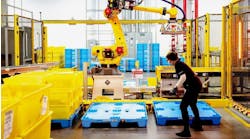Smart Social Distancing on the manufacturing plant floor
A silver lining within the dark cloud of the COVID pandemic is the technology boon prompted by new
Software AG's Bernd Gross
worker-safety needs. Case-in-point: Software AG’s new Smart Social Distancing solution that promises to enable workers to return, safely, to plant floors while complying with GDPR and other privacy regulations.
The solution uses smart badges to alert the wearer if they approach the limit of safe distancing from peers. The badges interact with beacons placed at cluster points throughout the workplace. (Check out a video of the tool in action here.)
We wanted to learn more, so we connected with Bernd Gross, Software AG’s CTO, to explore how the IoT is going to get us back to normal working conditions. Take a look…
Smart Industry: How do you define "smart social distancing"? What does that mean and why is it important in the current industrial environment?
Bernd: Smart social distancing is a way for organizations to safely return to work. Using technology to monitor and influence behavior around physical distancing means employers have an ever-present monitor for safety and wellbeing.
Simply asking employees to socially distance is not enough. We are naturally social creatures, and sometimes without realizing it we can find ourselves within the recommended distance from other people. This is where technology helps. Our Smart Social Distancing solution reminds people of safe distances—a badge that the employee wears will buzz, beep or flash when they get too close to another badge.
The first goal is to ensure safe behaviors. However, knowing that on occasion there will be breaches, the solution can record them. So if someone does become ill, it’s possible to identify who came into contact with them. This helps protect employees, but is also auditable proof of compliance for authorities in regions where businesses need that in order to stay open.
As you move forward with your social-distancing solution decisions, be sure to consider the impact that an optimized IoT-based solution will have on:
- Productivity—With a clear plan in place, factories and offices will be able to open quickly, while conforming and adapting to new regulatory requirements. Since our IoT-based solution allows policy to be updated centrally through a unified platform, it is extremely adaptable as conditions change
- Worker safety—Workers can get information to help adapt their behavior and trust that if they have been exposed to a coworker who is experiencing symptoms, they can take immediate action. It’s a business’ responsibility to ensure worker health and safety. It’s also in their best interest to maintain a healthy (and happy) workforce
Smart Industry: What is the reaction to this technology among workers—those whose movements are being monitored?
Bernd: The Göbecke bakery in Germany is one of the first companies to trial the solution. Owner Christine Göbecke said, “Just like so many other businesses, the current situation is tough for us and holds many challenges. But thanks to the Smart Social Distancing solution, the safety of our workers is guaranteed and we can focus on getting to a point of normality in our production.”
Employees like it. We saw through the trial that when people become focused on their day-to-day tasks they don’t notice that they’re close to someone else. The badges give a friendly reminder and the employees like that.
People have to wear the badges, but they’re not heavy or too bulky. So they’re not physically invasive or distracting. In addition, because they don’t need to provide any personal information in order to set them up, they feel more comfortable about the ‘data exchange’—or lack of it—required to use it and protect themselves.
Beta tests in food production facilities and process manufacturing plants have shown that instances of breaches declined by more than 50% within the first week.
Smart Industry: How is the IoT quickening the return to normalcy in the manufacturing space?
Bernd: Returning to work following the COVID-19 pandemic isn’t the end of social distancing. It is just the beginning of a prolonged new normal. Businesses will have to be flexible and vigilant to ensure worker and customer well-being, business resilience and regulatory compliance. Using wearables and the IoT to help discreetly alert coworkers when they get too close, and to anonymously create a contact history—using proximity data, not location—in case of infection, is the new method the manufacturing industry will have to adhere to moving forward.
Employees on the manufacturing floor and construction sites have enough to think about without constantly trying to keep their distance from colleagues. Smart social-distancing solutions can automate social distancing and alert them when they are too close to a colleague for too long—so they can keep their mind on the important (and sometimes dangerous) work they are doing.
Smart Industry: Explain how this solution is a stepping stone for engaging in larger venues? What types of venues?
Bernd: The Smart Social Distancing solution from Software AG is just the first stone being laid in a complex and rapidly evolving social foundation. While the solution is currently being used for safe return-to-work circumstances, there are many new opportunities right around the corner. One of the most popular topics on people’s minds is the return of venue-based events. This solution proves that returning to normal, even in a large venue-type setting, is possible with a helping hand from technology. The solution is just the first spark in an ongoing mission to resume normalcy with a sense of calm and safety.
According to a recent survey from Experience Measures Fan Perspective, nearly 55% of fans are ready to return to live events today, with the other 45% cautiously optimistic to come back within the year once events return if crowd sizes are limited and social-distanced seating options are offered. As the situation evolves over the next few months, we are certain to see solutions that will allow for the events industry to thrive again using high-tech smart social-distancing solutions for venues. Industries such as entertainment and sports will once again be able to house eager fans and advance the fan experience in a whole new and distanced way using the IoT.
Smart Industry: What positives will come out of this challenging period?
Bernd: Our industry is working tirelessly to resurface from this challenging period with more positives than negatives, more strategies and more business continuity planning skills than before. In order to be armed for future incidents and able to resume normal business operations faster despite unforeseen situations, companies must learn lessons from the situation they have just overcome. Post-crisis should not look like before the crisis. Some processes that were originally envisioned as a transitional solution will become established and shape day-to-day business. Examples include digital tools for internal and external communication with customers, home-office rules and new digital marketplaces that could supplement analog procurement measures. If a new software tool has become established in some departments, you should analyze whether the solution could provide meaningful support for other areas. New processes need to be actively integrated into everyday business activities. You need to fully exploit the potential of digital tools to slim down processes even further while boosting productivity and effectiveness.
Here are a few constructive essentials that have been uncovered due to the COVID-19 pandemic:
- It is essential to create an emergency-management plan that catalogues threatening business risks
- Business teams must be able to define effective countermeasures, along with a clear allocation of responsibilities for initiating and implementing those measures
- Agility and transparency are everything—and deserve to be developed and acknowledged on an ongoing basis. Communication is essential, all stakeholders in any process or across the supply chain must be informed in a timely manner
- Leadership and executive unity need to be practiced and reinforced on an ongoing basis in order to ensure resilience during times of uncertainty
- Your businesses can be reborn in ways you never imagined. You can and should make provisions for a digital future
- Invest in digital support for all core processes in order to substantially reduce negative impact for customers, partners and employees during a crisis
- An ‘employee's-first’ structural foundation will enable for positive business results in the long run
- A rapid analysis of risk processes and prioritization of all impending measures is necessary to best protect areas like distribution and logistics, which are often impacted heavily by crises
Software can support the crisis-resilience of companies in any industry. For this reason, businesses should seize the opportunity and protect their processes with digital tools according to the latest standards. Being more effective can not only save lives and business, but that effectiveness harbors additional potential that can bring you a key advantage in times of growing competitive pressure.




